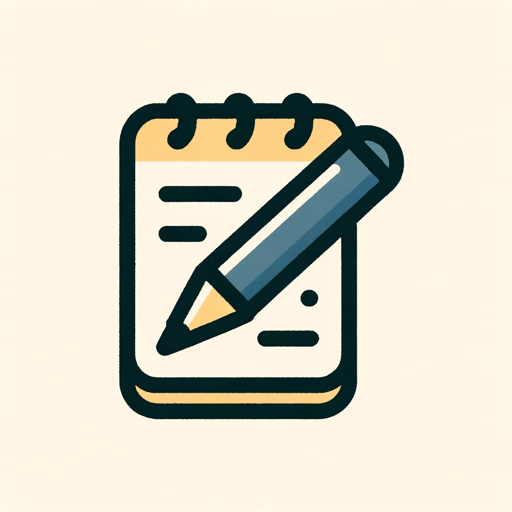Class Note Taking-AI-powered note-taking tool
AI-powered class note-taking tool.
Summarize this lecture on biology.
How should I organize notes for my history assignment?
Create notes from this article for my presentation.
I have a class speech text, can you make notes?
Related Tools
Load More
Notes Scribe
I convert your study material into detailed notes, flowcharts, and PDFs

Note-Taker
Expert at creating clear, concise, and comprehensive bullet-point notes.

Lecture Notes
Creating detailed, organized lecture notes from transcripts.

Lecture Notes From Slides
Generates notes from slides in a clear, engaging style.

Smart Notes
A smart assistant for creating effective academic notes.

Pro Class Notes Taker
I will create your class notes based on your audio transcript! Share an audio transcript from your class, and I will output class notes. I will provide: 1) logically structured text 2) list of keywords and a 3) lecture summary.
20.0 / 5 (200 votes)
Introduction to Class Note Taking
Class Note Taking is designed to assist users in efficiently capturing, organizing, and utilizing information from lectures, readings, and other educational activities. Its primary function is to facilitate the creation of concise, well-structured notes that can be easily reviewed and referenced for various academic purposes. The design emphasizes active engagement with the material, encouraging users to summarize information in their own words, identify key points, and establish connections with existing knowledge. For instance, during a biology lecture on cell structure, Class Note Taking would help a student outline the main components of a cell, note important details about each part, and relate this information to broader biological concepts.

Main Functions of Class Note Taking
Linear Note Taking
Example
A student attending a history lecture uses linear notes to sequentially record events discussed by the lecturer.
Scenario
During a lecture on World War II, the student notes the chronological order of major battles, important dates, and key figures mentioned by the professor.
Diagrammatic Note Taking
Example
A student in a psychology class uses a mind map to organize concepts related to cognitive development theories.
Scenario
In a discussion about Piaget's stages of cognitive development, the student creates a mind map linking each stage to its characteristics, examples, and related experiments.
Pattern Notes
Example
A student reading a complex scientific article uses pattern notes to highlight recurring themes and concepts.
Scenario
While studying a paper on climate change, the student identifies and notes down recurring patterns such as the impact of greenhouse gases, feedback loops, and mitigation strategies, connecting these patterns to various sections of the text.
Ideal Users of Class Note Taking Services
Students
Students at all levels, from high school to university, can benefit from Class Note Taking. It helps them organize lecture material, prepare for exams, and complete assignments more efficiently. By promoting active engagement with the content, students are more likely to retain information and understand complex concepts.
Professionals and Lifelong Learners
Professionals attending training sessions or conferences, as well as individuals engaged in self-directed learning, can use Class Note Taking to capture and organize information effectively. This tool aids in the retention and application of new knowledge, making it easier to refer back to key points and integrate new insights into their work or personal development.

How to Use Class Note Taking
Visit aichatonline.org
Visit aichatonline.org for a free trial without login, also no need for ChatGPT Plus.
Prepare for Note Taking
Identify your purpose for taking notes, such as attending lectures, writing assignments, or preparing for exams. Gather any necessary materials like textbooks or lecture slides.
Choose a Note Taking Method
Decide on a format that suits your needs: linear, diagrammatic, or pattern notes. Use active note-taking strategies to engage with the material.
Take Notes Effectively
Write in your own words, keep direct quotes brief, and make notes selective. Show relationships between points, summarize in your own words, and use illustrations or diagrams.
Review and Organize Notes
After the session, review your notes for clarity. File them systematically for easy access later, and consider revising or expanding them based on further study.
Try other advanced and practical GPTs
Class Diagram Creator
AI-powered tool for class diagrams.

World Class Colab Engineer
AI-powered Colab notebook enhancement

Pro Class Notes Taker
AI-Powered Class Notes in Minutes

World Class React Redux Expert
AI-powered guidance for React and Redux

Diagrams & Charts
AI-powered Diagrams for Clearer Insights

Brief Bot
AI-powered brief answers

T-Shirt Design
AI-Powered Creativity for Apparel Design

道家小T
Your AI-powered Daoist Guide

Note Taker Pro
AI-Powered Notes for Every Need

Note Taker
AI-driven tool for smarter transcription.

Test Taker
Your AI-powered academic support.

Ctrl + V - Check Your English
AI-powered tool for perfecting your English.

- Research
- Exam Prep
- Presentations
- Lectures
- Assignments
Class Note Taking Q&A
What is the main purpose of Class Note Taking?
Class Note Taking helps users capture and organize information from lectures, readings, or presentations effectively, enhancing understanding and retention.
Can I use Class Note Taking for exam preparation?
Yes, it is designed to help you create comprehensive and organized notes that can be easily reviewed and studied for exams.
What note-taking methods are supported?
Class Note Taking supports various methods including linear, diagrammatic, and pattern notes, allowing users to choose the format that best suits their learning style.
How can I ensure my notes are effective?
To make your notes effective, write in your own words, keep them brief and selective, show relationships between points, and use illustrations or diagrams to visualize information.
What should I do after taking notes?
Review your notes for clarity, file them systematically, and consider revising or expanding them based on further study or additional information.